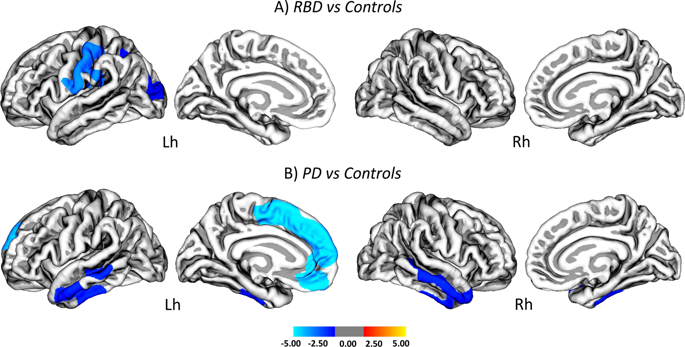npj Parkinson's Disease ( IF 6.7 ) Pub Date : 2019-05-03 , DOI: 10.1038/s41531-019-0079-3 Joana B. Pereira , Daniel Weintraub , Lana Chahine , Dag Aarsland , Oskar Hansson , Eric Westman

|
The aim of this study is to determine whether structural MRI measures are associated with clinical impairment and progression to a Lewy body disease in patients with idiopathic REM sleep behavior disorder (iRBD). Twenty-seven patients with iRBD in addition to patients with de novo PD and healthy controls were included from the Parkinson’s Progression Markers Initiative. Patients with iRBD were followed for up to 3 years. Clinical and MRI measures were compared across groups and the association between clinical features and structural MRI was assessed in iRBD patients. Cox regression analyses were applied to identify risk factors for progressing to a Lewy body disease in iRBD. Our results showed that, at baseline, iRBD patients showed parietal and occipital cortical thinning, compared to controls. They also showed worse motor and non-motor abilities, some of which correlated with motor, frontal or temporal cortical thinning. At follow-up, six (22%) iRBD patients were diagnosed with a Lewy body disorder. These patients showed cortical thinning in frontal, occipital and parietal areas compared to iRBD non-converters. Cortical thinning was a significant predictor for future development of a Lewy body disorder (HR: 0.784; 95% CI: 0.640–0.960; p = 0.02). We conclude that cortical thinning is associated with worse motor and non-motor abilities, and predicts conversion to a Lewy body disorder in iRBD, suggesting it could be used to select candidates for clinical trials to delay the onset of neurodegenerative disease.
中文翻译:

REM睡眠行为障碍患者的皮质变薄与临床进展有关
这项研究的目的是确定结构性MRI措施是否与特发性REM睡眠行为障碍(iRBD)患者的临床障碍和发展为路易体病有关。除帕金森氏病进展指标计划外,还有27名患有iRBD的患者以及从头PD和健康对照者。对iRBD患者进行了长达3年的随访。比较了各组的临床和MRI指标,并评估了iRBD患者的临床特征与结构性MRI之间的关联。应用Cox回归分析确定iRBD中进展为路易体病的危险因素。我们的结果表明,与对照组相比,iRBD患者在基线时显示顶叶和枕叶皮质变薄。他们还表现出较差的运动和非运动能力,其中一些与运动,额叶或颞皮质变薄有关。在随访中,六名(22%)iRBD患者被诊断出患有路易体病。与未转化的iRBD相比,这些患者的额叶,枕叶和顶叶皮层变薄。皮质变薄是路易氏体病未来发展的重要预测指标(HR:0.784; 95%CI:0.640-0.960; p = 0.02)。我们得出的结论是,皮层变薄与较差的运动和非运动能力有关,并预测iRBD会转变为路易体病,这表明它可用于选择临床试验的候选人,以延缓神经退行性疾病的发作。六名(22%)iRBD患者被诊断出患有路易体病。与未转化的iRBD相比,这些患者的额叶,枕叶和顶叶皮层变薄。皮质变薄是路易氏体病未来发展的重要预测指标(HR:0.784; 95%CI:0.640-0.960; p = 0.02)。我们得出的结论是,皮层变薄与较差的运动和非运动能力有关,并预测iRBD会转变为路易体病,这表明它可用于选择临床试验的候选药物,以延缓神经退行性疾病的发作。六名(22%)iRBD患者被诊断出患有路易体病。与未转化的iRBD相比,这些患者的额叶,枕叶和顶叶皮层变薄。皮质变薄是路易氏体病未来发展的重要预测指标(HR:0.784; 95%CI:0.640-0.960; p = 0.02)。我们得出的结论是,皮层变薄与较差的运动和非运动能力有关,并预测iRBD会转变为路易体病,这表明它可用于选择临床试验的候选人,以延缓神经退行性疾病的发作。









































 京公网安备 11010802027423号
京公网安备 11010802027423号